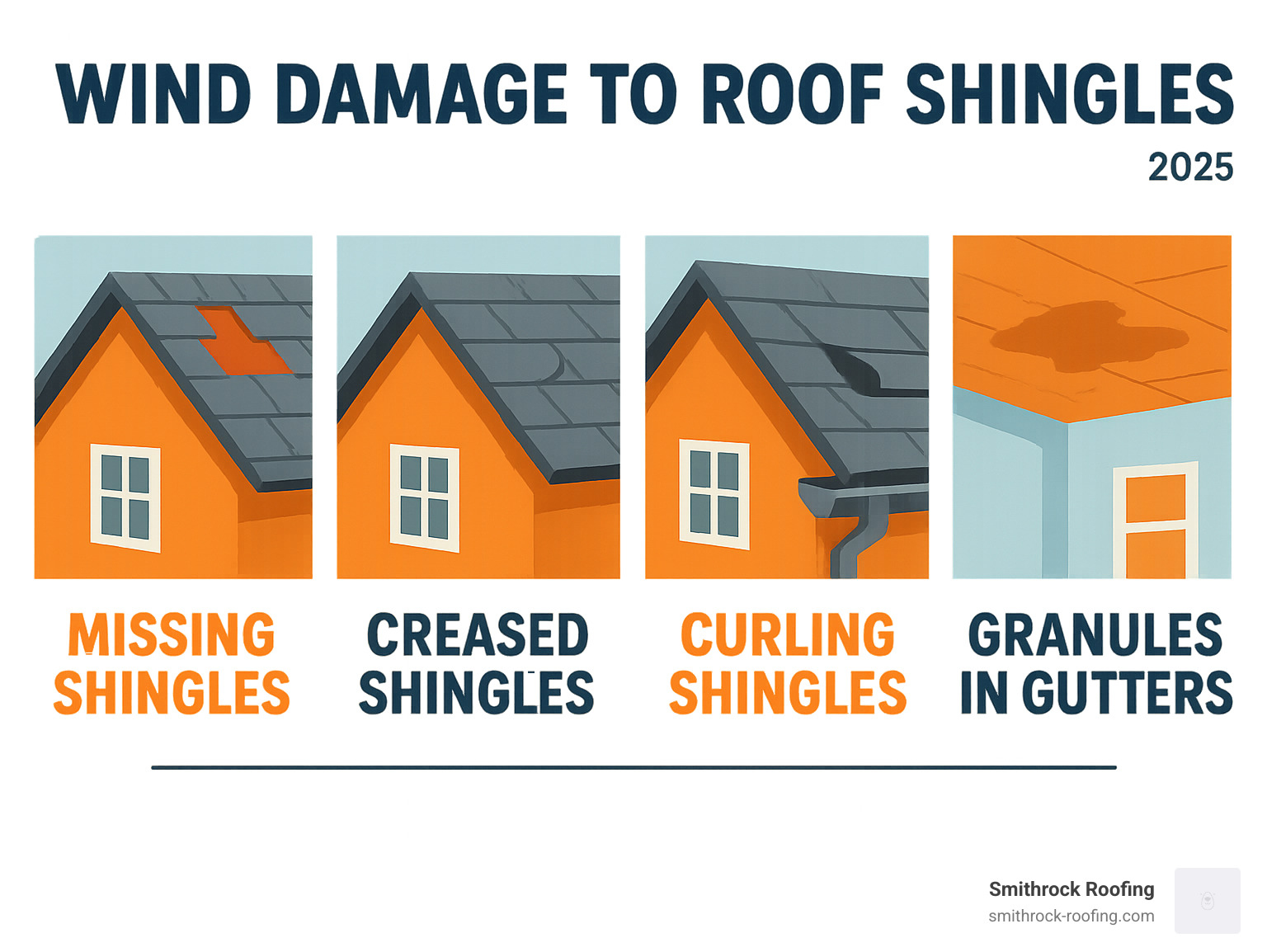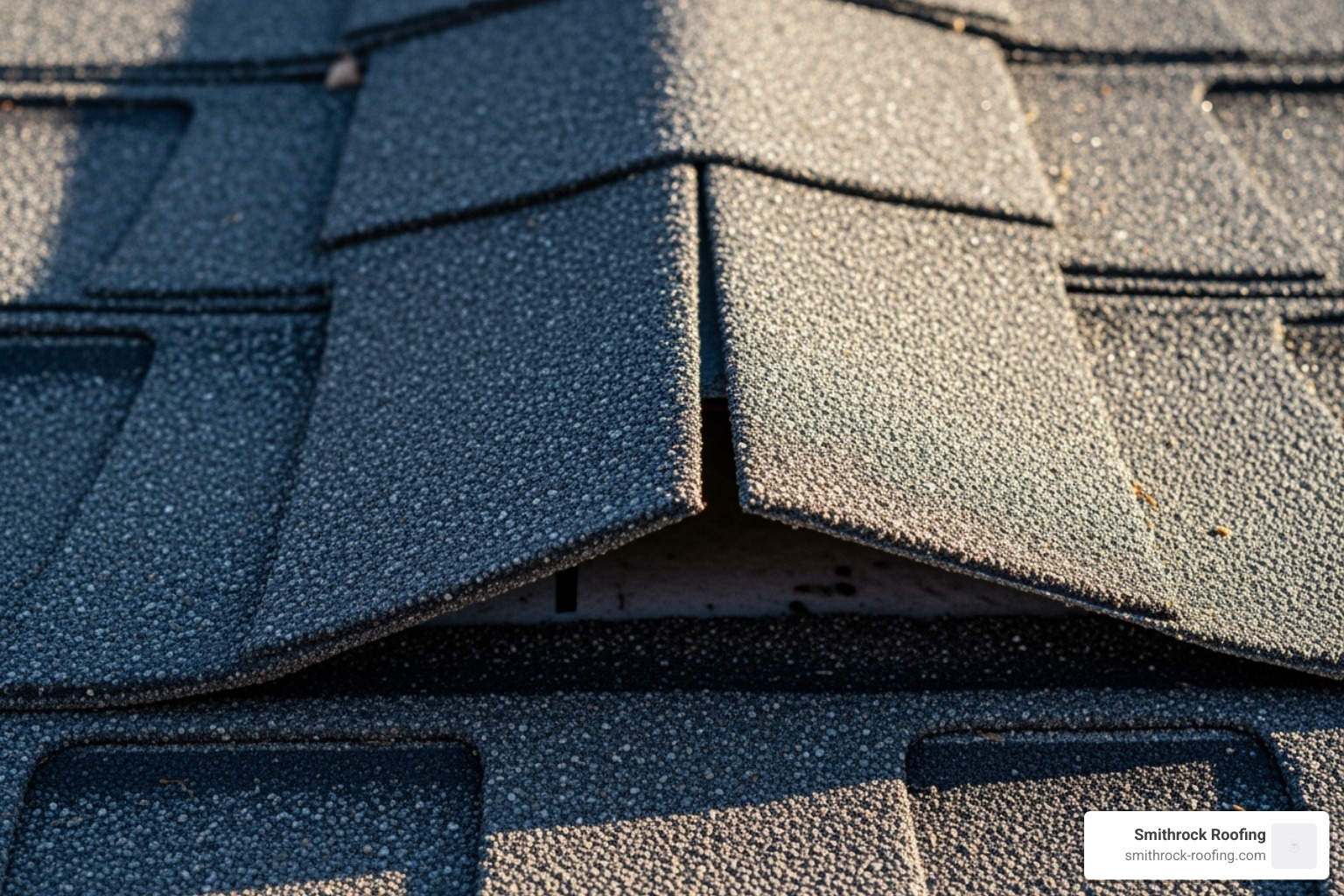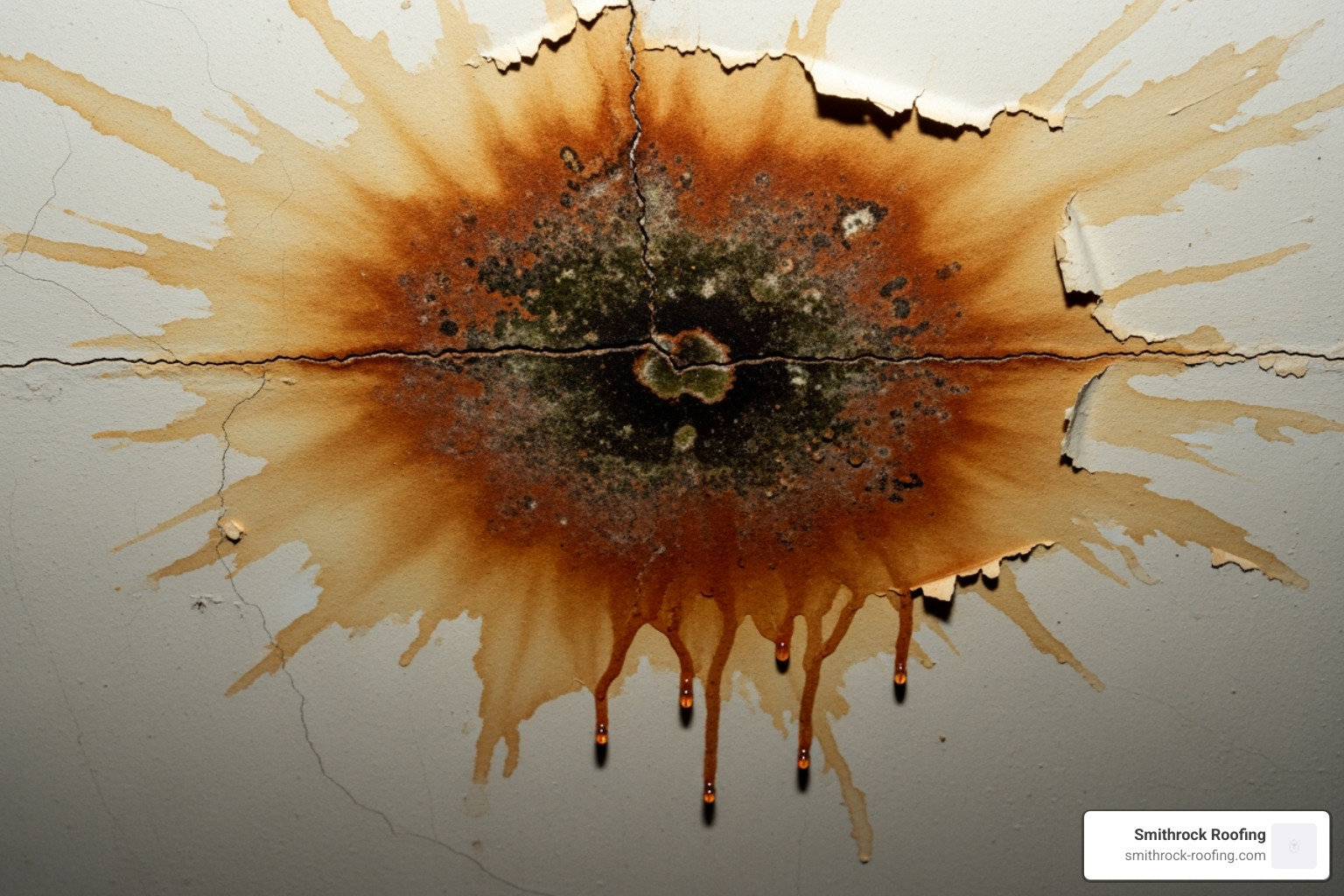Wind damage to roof shingles: Avoid 5 Hidden Dangers
Why Wind Damage to Roof Shingles Is More Common Than You Think
Most homeowners underestimate the power of wind. Wind damage to roof shingles can begin with gusts as low as 45 mph. After a storm, it’s crucial to check for these key signs:
- Missing shingles – Obvious gaps where shingles have been blown off.
- Lifted or curling edges – Shingles that appear to be peeling away from the roof.
- Creased shingles – Visible fold lines where the wind has bent the shingle.
- Granules in gutters – An excessive amount of the sand-like coating from your shingles.
- Water stains inside – Discoloration on ceilings or leaks in the attic.
As one roofing expert notes: “Even low wind speeds during a typical thunderstorm can damage shingle roofs, which can see escalating effects as wind speed increases.”
Unlike obvious hail damage, wind damage can be subtle and progressive. A single loose shingle allows wind to get underneath adjacent ones, creating a chain reaction that can lead to widespread failure across your roof. This compromises your roof’s protective barrier, allowing water to infiltrate your home and cause mold, insulation damage, and even structural issues. A minor shingle repair can quickly escalate into thousands of dollars in damage if ignored.
This guide will teach you what to look for, when to be concerned, and how to protect your home. I’m Jordan Smith, and with over 15 years in exterior construction, I’ve seen how easily wind damage to roof shingles can be missed. My experience helps me identify the subtle signs that can prevent costly disasters.

Wind damage to roof shingles glossary:
How Wind Interacts with Your Roof: The Science of Damage
To understand how wind damage to roof shingles occurs, it’s helpful to think of your roof as an airplane wing. Wind doesn’t just push against your roof; it flows over and around it, creating complex aerodynamic forces that can lift, tear, and strip away your home’s primary defense against the elements.
Wind generates both positive pressure and negative pressure. Positive pressure is the direct force of the wind pushing against the windward side of your roof (the side facing the wind). While this force is significant, the more destructive force is often negative pressure, also known as suction or “wind uplift.” As wind flows over the curved surface of your roof, its speed increases, causing the pressure to drop—this is an application of Bernoulli’s principle. This low-pressure zone above the roof acts like a powerful vacuum, pulling shingles upward and away from the roof deck.
This uplift is not uniform across the entire roof. It is most intense at the most vulnerable points: the corners, the eaves (edges), and the ridge (the peak). These areas create turbulence, allowing wind to get a foothold underneath the shingles. Once a single shingle’s seal is broken and it begins to lift, it acts like a lever, exposing the underside of adjacent shingles to the wind. This initiates a devastating chain reaction of damage, where the failure of one shingle leads to the failure of many, rapidly turning a small vulnerability into a widespread problem. The surrounding environment, such as nearby trees or buildings, can also create wind tunneling and unpredictable turbulence, focusing intense gusts on specific areas of your roof.
The amount of wind damage to roof shingles depends heavily on wind speed, but even moderate winds can cause trouble on a vulnerable roof. You can learn more about how wind impacts structures from research by the National Severe Storms Laboratory.
Wind Speed and Its Impact
You might be surprised that wind damage to roof shingles doesn’t require a hurricane. Damage can occur at lower speeds than most people think, especially when factors like roof age and installation quality come into play:
- Slight Damage (45-57 mph): These winds, common in strong thunderstorms, can cause subtle but significant damage. They can break the sealant strips on shingles, causing them to lift or “flap.” While you may only see broken tree branches on the ground, your roof could be sustaining the initial damage that sets it up for failure in a future storm.
- Severe Damage (58-74 mph): At these speeds, which are just below hurricane force, significant damage is likely. Even well-maintained shingles can be creased, torn, or ripped completely from the roof. Winds in this range can strip away your roof’s protective layer, leaving the underlayment exposed to rain.
- Widespread Damage (75+ mph): Hurricane-force winds will test even the strongest roofing systems. Widespread shingle loss, damage to the underlying roof deck, and even structural failure are common. While most new architectural shingles are rated for winds up to 110 mph or even 130 mph, sustained winds over 75 mph pose a serious threat to any roof.
It’s critical to remember that these are just guidelines. Damage can occur even at 30 mph on older, brittle roofs or those with poor installation. Wind speed is a major factor, but it isn’t the only one.
Spotting the Telltale Signs: A Homeowner’s Inspection Checklist
After a storm, your safety is paramount. Only inspect your roof from the ground or inside your home. Climbing on a potentially damaged and slippery roof is extremely dangerous; always call a professional if you suspect extensive damage or cannot inspect it safely. As one expert notes, “Unlike hail damage, which takes a trained eye to see, wind damage is easier to spot” – if you know what to look for.
Obvious Signs You Can See from the Ground
A slow, careful walk around your property can reveal a lot. Use binoculars and a camera with a zoom lens to get a safe, detailed look from the ground without ever setting foot on a ladder.
- Missing Shingles: This is the most obvious sign. Look for shingles or pieces of shingles in your yard, on your driveway, or in your landscaping. On the roof, you’ll see noticeable gaps or patches of a different color where the exposed underlayment or older shingles underneath are visible.
- Lifted or Curling Shingles: Scan the surface of your roof for shingles where the edges and corners appear to be peeling upward. This indicates the sealant strip has been broken by wind uplift. This repeated lifting and flapping fatigues the shingle, making it brittle and prone to tearing off in the next storm.
- Creased or Folded Shingles: Look for a horizontal line or fold mark across a shingle. This happens when the wind violently bends the shingle backward, fracturing the fiberglass matting inside. A creased shingle is a compromised shingle and a likely future leak point, even if it lays flat again.

- Shingle Granules in Gutters: Check your gutters and downspout splash blocks for an excessive accumulation of black, sand-like granules. These granules are the shingle’s primary layer of protection against UV rays and hail. Significant granule loss, often caused by the stress of wind flapping or impacts from debris, exposes the underlying asphalt to the sun, accelerating the aging process and making the shingle brittle.
- Damaged Soffit or Fascia: Check the boards along your roof’s edge (fascia) and overhang (soffit) for dents, cracks, or detachment. Damage here suggests significant wind force on your entire roof system and can create entry points for water and pests.
- Debris on the Roof: Tree limbs, branches, or other debris on your roof are a clear sign of a strong wind event. This debris may have caused punctures, scratches, or impact damage that needs a closer look from a professional.
Here are the essential tools for a safe ground-level inspection:
- Binoculars
- Camera with zoom lens
- Notepad
Subtle and Hidden Signs of Damage
Sometimes the most critical wind damage to roof shingles is hidden from view. These signs often appear inside your home, long after the storm has passed.
- Attic Inspection: With a good flashlight, carefully check your attic. Look for water stains, damp spots, or discoloration on the underside of the roof deck, rafters, and insulation. Wet insulation loses its R-value, increasing energy costs, and can become a breeding ground for mold. A musty smell is a major red flag.
- Water Leaks or Stains on Ceilings: Discolored patches, peeling paint, or active drips on ceilings and upper walls are clear signs of a roof leak originating from compromised shingles. Pay close attention to areas around ceiling fixtures, fans, and the corners of rooms.
- Daylight Visible Through Roof Boards: On a bright day, go into your attic and turn off the lights. Look up at the roof deck. Even tiny pinpricks of light indicate a hole from a popped nail or missing shingle that water can easily penetrate.

- Sudden Increase in Energy Bills: If your HVAC system is working harder than usual to heat or cool your home, it could be due to wind damage creating openings in your roof. This compromises your attic’s insulation and ventilation, allowing conditioned air to escape.
- Unwanted Attic Guests: Small openings from wind-damaged soffits or missing shingles can become easy entry points for squirrels, rodents, birds, and insects. Sudden signs of pests in your attic could be a clue to unseen roof damage.
Why Some Roofs Suffer More: Key Risk Factors for Wind Damage to Roof Shingles
Not all roofs respond to wind the same way. A brand-new roof on one home might survive a storm unscathed, while a 15-year-old roof next door suffers catastrophic failure. A roof’s vulnerability to wind damage to roof shingles depends on a combination of its age, materials, design, and, most importantly, the quality of its installation.
Roof Age and Material Condition
As a roof ages, its materials naturally degrade, making it more susceptible to wind. The typical asphalt shingle lifespan is around 20 years, but its peak wind resistance declines much sooner.
- Sealant Strip Degradation: Shingles have a strip of thermally activated asphalt sealant that bonds them to the course below. This seal is most effective for the first 4-5 years. After that, heat and time cause it to become less pliable, making it easier for wind to break the bond and lift the shingles.
- Brittleness with Age: Over time, the volatile oils in asphalt shingles evaporate, causing them to become brittle. An older shingle is more likely to crack, fracture, or tear in high winds rather than flex.
- Shingle Type and Material: The type of shingle matters significantly. After Hurricane Frances, research showed that 87% of roofs with thicker laminated (architectural) shingles had little to no damage, compared to only 44% of roofs with standard, thinner 3-tab shingles. While asphalt is most common, other materials offer varying performance. Properly installed metal roofing with interlocking panels provides exceptional uplift resistance. Clay and concrete tiles are heavy and durable but can be vulnerable if not mechanically fastened to modern standards.
Installation Quality and Roof Design
Even the best materials will fail if not installed correctly. Improper fastening is the leading cause of premature wind damage. Research after Hurricane Frances found that an astonishing 10 out of 11 roofs examined had incorrectly fastened shingles.
- Nail Placement and Depth: Nails must be placed precisely in the manufacturer’s designated nailing strip. If they are too high, the shingle has no structural support against uplift. If they are too low (overdriven), the nail head cuts through the shingle, weakening it. Under-driven nails prevent the shingle above from sealing correctly.
- Use of Starter Strips: A critical but often overlooked component is the starter strip, a special course of shingles installed at all eaves and rakes (the angled edges). These strips have adhesive along the edge to prevent wind from getting under the first course of shingles, which is the most vulnerable area.
- Roof Shape and Pitch: The design of your roof affects how it handles wind. Gable roofs (two-sided, A-frame) are more susceptible to uplift, especially those with large overhangs. In contrast, four-sided hip roofs are more aerodynamic, allowing wind to flow over them more smoothly and reducing uplift forces. Generally, steeper roof pitches (from 4:12 to 6:12) perform better by encouraging smoother airflow.
The Role of Building Codes and Environment
Local building codes, often based on standards like the ASCE 7 (Minimum Design Loads for Buildings and Other Structures), play a huge role. In high-wind zones or hurricane-prone coastal areas, codes mandate stricter installation practices, such as requiring six nails per shingle instead of the standard four and specifying certain types of underlayment. The surrounding environment also matters; a home in an open field is exposed to more direct wind force than one in a dense, wooded subdivision. Quality installation that follows or exceeds local codes is essential for wind resistance, which is why we stress the importance of professional work and offer Benefits of Regular Roof Inspections to maintain your roof’s integrity.
From Prevention to Action: Protecting Your Roof and Responding to Damage
Proactive prevention is the best defense against wind damage. Taking steps before storm season and having a clear action plan for afterward can save you significant money and stress. Strengthening your roof’s defenses and knowing what to do when a storm hits are key to protecting your home.
Proactive Prevention Strategies
The best time to prepare for wind damage to roof shingles is during clear weather.
- Choose Wind-Resistant Shingles: When replacing your roof, select shingles with high wind-resistance ratings. Look for classifications from ASTM International wind resistance standards (D3161, D7158). Class F shingles are rated for 110 mph winds, while Class H can withstand 150 mph.
- Ensure Professional Installation: The highest-rated shingles will fail if installed improperly. Professional installation ensures every nail is placed correctly and every sealant strip is properly activated to create a unified, wind-resistant barrier.
- Schedule Regular Maintenance: Treat a roof inspection like an annual health check-up. A professional can spot and fix vulnerabilities like loose shingles or aging sealant before a storm turns them into major problems.
- Prepare Your Property: Trim overhanging tree branches that could fall and damage your roof during a storm. Secure outdoor furniture, grills, and decorations that could become airborne projectiles.
Once the storm has passed, take these steps to assess and address the damage.
- Prioritize Safety: Before inspecting, check for downed power lines and other hazards around your home. Never climb onto a storm-damaged roof yourself; its stability may be compromised. Leave this to professionals.
- Document Everything: Use your phone to take detailed photos and videos of all visible damage from multiple angles. Capture missing shingles, creases, and any debris on the roof. Also, photograph any interior damage like water stains. This documentation is vital for insurance claims.
- Make Temporary Repairs (If Necessary): If you have active leaks or large exposed areas, covering damaged areas with a tarp can prevent further water damage. However, this is a dangerous task that is best left to a professional to avoid injury and ensure the tarp is secured correctly.
- Contact a Professional: The most important step is to call for a professional assessment. A trained roofer can identify subtle wind damage to roof shingles that you might miss. Our Emergency Roofer Services team can respond quickly to secure your home and provide an expert evaluation. Timely repairs prevent minor issues from becoming major structural problems.
Navigating the Aftermath: Insurance, Repairs, and Common Myths
Dealing with the aftermath of a storm involves insurance claims, contractor negotiations, and critical repair decisions. Understanding your policy and separating fact from fiction will help you steer the process of fixing wind damage to roof shingles effectively and avoid costly mistakes.
Understanding Your Insurance Coverage
Most homeowners’ insurance policies cover wind damage, but the details of your coverage are what truly matter.
- Review Your Policy (ACV vs. RCV): Before you even file a claim, locate your policy documents. Look for sections on roof damage and your deductible. Most importantly, determine if you have an Actual Cash Value (ACV) or Replacement Cost Value (RCV) policy. ACV pays for the depreciated value of your old roof, leaving you to cover the difference for a new one. RCV pays the full cost to replace your roof with new, similar materials. RCV coverage is far superior for homeowners.
- File a Claim Promptly: Insurance policies require you to report damage in a timely manner. Contact your insurance company as soon as you find damage. Provide them with the photos and notes you took during your initial inspection. Your insurer will send an adjuster to assess the damage.
- The Role of Your Roofer: While an insurance adjuster works for the insurance company, a reputable roofing contractor works for you. Your roofer can meet the adjuster on-site to ensure all damage is identified and properly documented, providing a detailed, line-item estimate that justifies the scope of work needed. This advocacy is crucial for a fair settlement.
- Document All Communication: Keep a detailed log of every phone call, email, and letter with your insurance company. Note the date, time, the name of the person you spoke with, and what was discussed. This paper trail is invaluable if any disputes arise.
Repair or Replace? Making the Call for Wind-Damaged Roof Shingles
Deciding whether to repair or replace your roof depends on its age and the extent of the damage.
- When to Repair: A simple repair may be sufficient for minor, localized damage—like a few missing shingles in one area—on a relatively young roof (under 10-12 years old) that is otherwise in good condition.
- When to Replace: A full replacement is often necessary if the roof is approaching the end of its 20-year lifespan, the damage is widespread across multiple sections, or if the shingle model has been discontinued, making a suitable match impossible. Replacement is also the best option if the damage has exposed underlying issues like rotted decking, as a patch repair will not solve the core problem.
A professional assessment can help you make the most cost-effective long-term decision. Our article on Roof Repair vs. Replacement in Winston-Salem: What Homeowners Need to Know offers more guidance.
Debunking Myths: The Truth About Wind-Damaged Roof Shingles
Misconceptions about wind damage to roof shingles can lead to poor decisions. Here’s the truth:
- Myth 1: Unsealed shingles are automatically considered wind-damaged. False. Shingle sealant naturally degrades after 4-5 years due to thermal cycling (expansion and contraction). Unsealed shingles without other physical evidence like creases or tears are typically considered a maintenance issue or wear and tear, not storm damage.
- Myth 2: Wind damage is always obvious. False. While missing shingles are easy to spot, subtle but destructive damage like creases, fractures, and severe granule loss requires a trained eye. A quick glance can miss the signs that point to a compromised roofing system.
- Myth 3: You have to accept the insurance company’s first offer. False. The initial estimate from an adjuster is a starting point. If your contractor finds additional, legitimate damage after starting the work (like rotted decking hidden under the shingles), they can file a supplement with the insurance company to cover the added costs.
- Myth 4: A small leak isn’t a big deal. False. Even a tiny leak can cause immense damage over time. It can saturate insulation, rot the wooden roof deck and structural supports, and lead to dangerous mold growth inside your walls and attic, turning a simple roof repair into a major remediation project.
Frequently Asked Questions about Wind Damage
Homeowners often have the same questions after a storm. Here are concise answers to the most common concerns about wind damage to roof shingles.
How strong does wind have to be to damage shingles?
Damage can begin at surprisingly low speeds. While new roofs are often rated for 110 mph winds, problems can start much sooner. Winds in the 45-57 mph range can lift and unseal shingles, especially on older or improperly installed roofs. Once winds exceed 58 mph, even shingles in good condition can be torn off. Your roof’s age and installation quality are just as important as wind speed.
Can I repair wind-damaged shingles myself?
While a simple DIY repair on a single, easily accessible shingle might seem feasible, roofing work is inherently dangerous. Working at heights on a potentially slippery or unstable surface can lead to serious injury. Furthermore, an improper repair can cause hidden leaks, void your roof’s warranty, or fail in the next storm. For any widespread wind damage to roof shingles, or to ensure the job is done safely and correctly, hiring a professional is always the best and safest choice.
Will my insurance premium go up if I file a wind damage claim?
Typically, filing a single claim for damage from a widespread weather event (often called an “Act of God”) will not cause your individual premium to increase. Insurance companies price their policies with the expectation of such events. However, after a major storm causes extensive damage across a region, an insurer might raise rates for everyone in that area to cover their losses, regardless of whether you filed a claim. Do not let fear of a rate hike stop you from filing a legitimate claim; that is what your insurance is for. It’s always wise to discuss your specific policy with your agent.
Secure Your Home with Confidence
You are now equipped to protect your home from wind damage. Your roof is your primary shield, and spotting wind damage to roof shingles early prevents small issues from becoming costly disasters. A well-maintained roof protects your home’s structure, improves energy efficiency, and preserves its value.
Don’t let wind steal your peace of mind. After a storm, or if you simply suspect an issue, a professional inspection is the wisest next step. At Smithrock Roofing, we provide thorough assessments and expert guidance to ensure your home is secure. We proudly serve Winston-Salem NC, King NC, Clemmons NC, and surrounding communities, bringing our expertise to your doorstep.
Get a professional roofing assessment today



